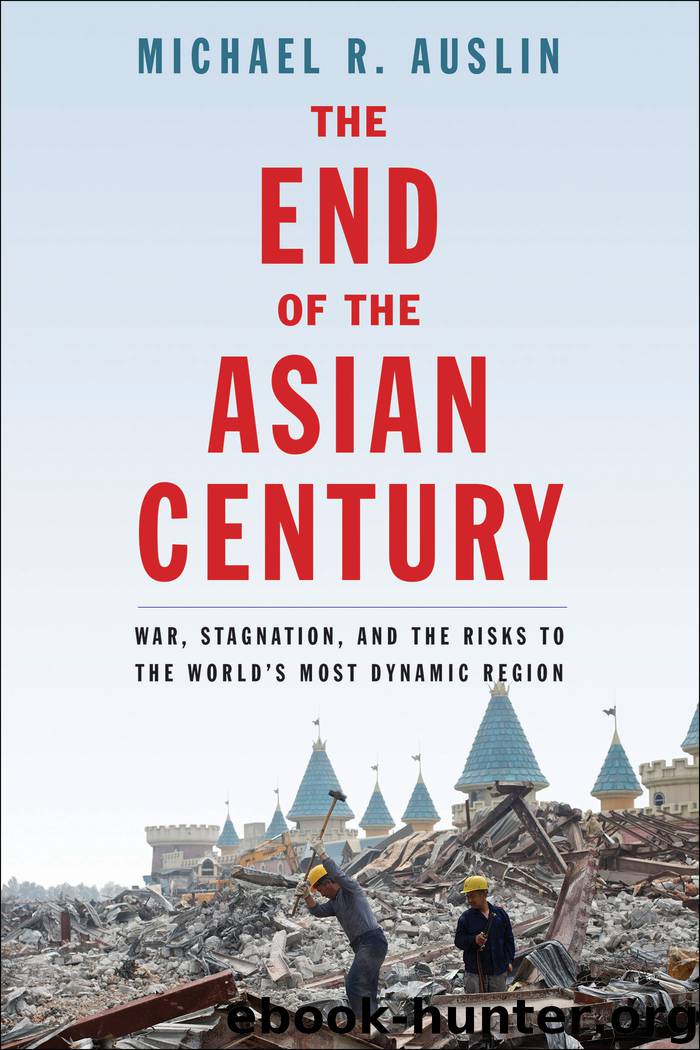The End of the Asian Century by Michael R. Auslin

Author:Michael R. Auslin
Language: eng
Format: epub
Publisher: Yale University Press
Published: 2016-03-18T04:00:00+00:00
East Asian Summit Member States. Artwork by Claude Aubert.
It would be a mistake, of course, to see the EAS as Asia’s answer to the European Union. The EAS grew from political jockeying for influence between Japan and China with their Southeast Asian neighbors. As China’s influence in the ASEAN+3 process group grew with its economic power, Japan and some Southeast Asian nations called for the group’s expansion. Tokyo lobbied hard for three democratic nations to be added, thereby creating a nascent ASEAN+6. This soon morphed into the EAS, which quickly attracted Washington and Moscow.
Once the United States joined, the liberal tilt of the meeting became unmistakable, but the political gamesmanship also increased. What was intended as a forum for collaborative endeavor came increasingly to be seen as a zero-sum political game. For example, President Barack Obama attended the EAS in 2011–12 and 2014, further raising the summit’s profile; but when he skipped the meeting in 2013 because of a domestic budget showdown, international media portrayed it as a “win” for Chinese president Xi Jinping.52
Despite the attention it has drawn, the EAS, like ASEAN itself, has been hampered by unambitious agendas and a lack of agreement among members.53 For now, the summit has focused on uncontroversial issues such as trade and energy security or eliminating malaria, while human rights, rule of law, and traditional security questions have been far less prominent. Still, the EAS is important precisely because it is so highly valued by Asian nations, which are aware of the gap in their political relations. Many now find it inconceivable that the region’s nations would not hold an annual summit gathering, and while not sufficient, that alone is to be welcomed.
Bigger hopes are tempered by the understanding that the process is just beginning. With Russian and American participation, some have called the EAS “ASEAN+8,” but no matter how prestigious, it will remain largely a talking shop for some time. As with all things ASEAN, the EAS speaks more to hopes of real cooperation and the development of community than to any specific accomplishments.
For all the criticism leveled at ASEAN about its inability to turn itself into a more robust multinational organization, it has nonetheless made itself central to the Indo-Pacific environment. As the only indigenous multilateral political mechanism, it has become an important broker for bringing larger nations into regular regional discussions. Still, the limitations of its model are ever more apparent, and not always under the ASEAN nations’ control. Political community in Asia depends on the actions and attitudes of the region’s giants, yet China in particular remains ambivalent and often antagonistic to greater cooperation.
Influence without Friends: China’s Challenge
It was the diplomatic shot heard round the world. At the ASEAN Regional Forum in July 2010, China found itself ganged up on, perhaps for the first time on the global stage. When then-secretary of state Hillary Clinton made a widely reported comment that America considered it a U.S. national interest to have Southeast Asia’s territorial disputes settled peacefully, Chinese foreign
Download
This site does not store any files on its server. We only index and link to content provided by other sites. Please contact the content providers to delete copyright contents if any and email us, we'll remove relevant links or contents immediately.
International Integration of the Brazilian Economy by Elias C. Grivoyannis(75624)
The Radium Girls by Kate Moore(11634)
Turbulence by E. J. Noyes(7717)
Nudge - Improving Decisions about Health, Wealth, and Happiness by Thaler Sunstein(7261)
The Black Swan by Nassim Nicholas Taleb(6782)
Rich Dad Poor Dad by Robert T. Kiyosaki(6192)
Pioneering Portfolio Management by David F. Swensen(6089)
Man-made Catastrophes and Risk Information Concealment by Dmitry Chernov & Didier Sornette(5671)
Zero to One by Peter Thiel(5503)
Secrecy World by Jake Bernstein(4402)
Millionaire: The Philanderer, Gambler, and Duelist Who Invented Modern Finance by Janet Gleeson(4113)
The Age of Surveillance Capitalism by Shoshana Zuboff(3999)
Skin in the Game by Nassim Nicholas Taleb(3978)
The Money Culture by Michael Lewis(3857)
Bullshit Jobs by David Graeber(3847)
Skin in the Game: Hidden Asymmetries in Daily Life by Nassim Nicholas Taleb(3736)
The Dhandho Investor by Mohnish Pabrai(3573)
The Wisdom of Finance by Mihir Desai(3538)
Blockchain Basics by Daniel Drescher(3340)
